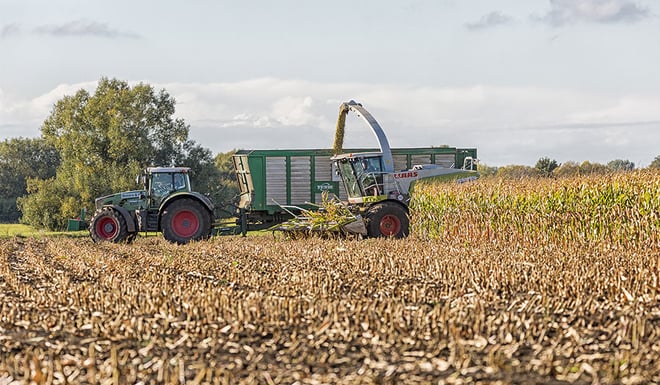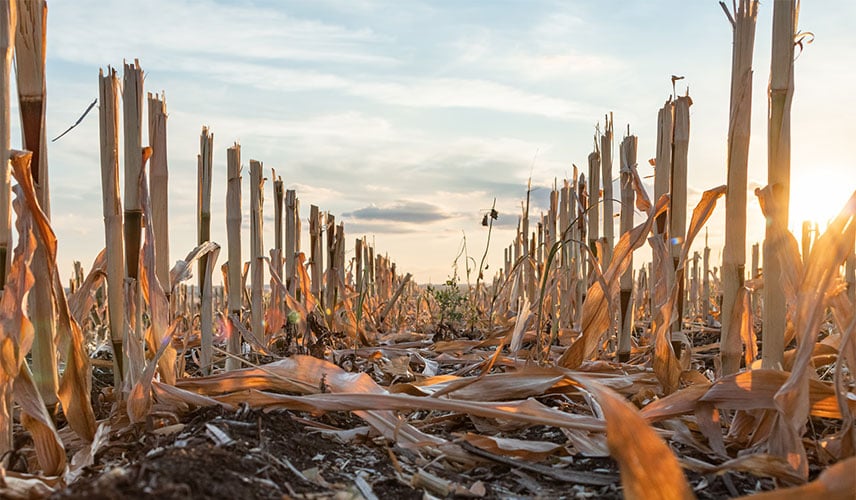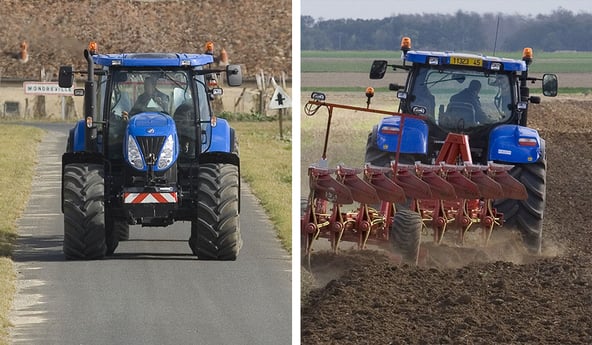There are numerous elements that are likely to cause wear to your tractor tyres or puncture them. Stubble from certain crops may easily wear, damage or puncture your tyres during harvesting or stubble ploughing. This is not a systematic problem but rather a frequent problem for which there are simple solutions that you can adopt to avoid breakdowns.
Corn stubble, for example, can cause major damage, as this type of crop with very thick, rigid stems can perforate a tyre. Repeated contact with thousands of slivers of stubble between the lugs may result in heavy wear, or even punctures, and block your operations completely. Certain tyres are better suited than others if you work regularly with corn, sunflower, soybean…
Here is everything you need to know about the impact of stubble on your tractor tyres.
1. Why can stubble cause problems for tyres?
Stubble has become a major concern for tyre manufacturers and certain crop farmers over the last decades. It can cause considerable damage to the rubber of the tread and to the sidewalls of your agricultural tyres, or even lead to repeated punctures.
Genetical crop evolution has made stubble harder over time
In order to improve yields, seed producers have turned to genetics to develop new hybrid crop varieties. These produce thicker, stronger stems which are more resistant to climatic conditions (storms or drought) and to insects or parasites.
This results in yields that are much higher, but after the harvest, it is much harder for the remaining stubble to decompose in the soil with the bad weather or change in season.
Stubble that is cut too short may contribute to agricultural tyre deterioration
There are advantages to choosing to cut the crops short when harvesting, such as avoiding driving over the land once more for stubble ploughing, or fighting against parasites such as the corn borer. But there are also disadvantages, in particular the risk of shortening your tyres’ lifespan or more frequent punctures caused by stubble piercing.
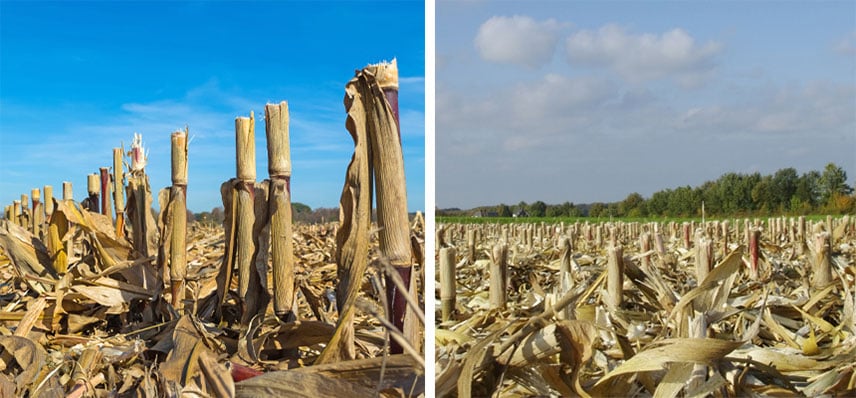 Stubble cut too short on the right leading to tyre damage
Stubble cut too short on the right leading to tyre damage
When rubber tractor tyres drive over these more brittle stubble stalks that are cut very short, this represents thousands of impacts between the lugs which will progressively tear off bits of rubber at the lug base, create cuts and end up getting through to the layers at the centre of the tread (see photo below). Fragments of corn stubble may then pierce the tyre and cause a puncture.
If you use tyres that are wider than the rows, there will be much more contact with the stubble than if you drive between the rows, thus increasing the risk of punctures at the lug base and at the level of the sidewalls.
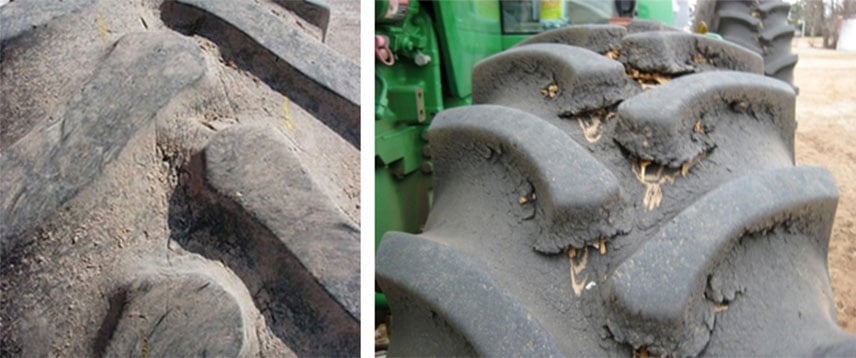 Cuts only at the level of the tyre’s lug base
Cuts only at the level of the tyre’s lug base
As long as the cuts at the level of the lug base remain superficial, the tyre is usable and there is no particular concern other than accelerated wear.
However, you must look closely at all the cuts which appear to be deeper as these can result in the tyre bursting if you increase inflation pressure for a long trip by road with the tractor loaded.
2. What are the solutions for reducing wear and avoiding punctures?
Before replacing your tyres and opting for a more resistant tyre model, there are a few ways to limit premature damage to your current tyres:
Don’t cut the stubble too short during the harvest
It is better to cut the stems a little higher up so that the tyres flatten them before driving over them, crushing them horizontally. Higher stems change the contact angle, which limits the chances of the stalks piercing the tread.
The additional quantity of stubble will no doubt mean that you have to carry out an extra stubble ploughing operation, but with the higher stalks your tyres are less at risk and this will lead to savings in the long run as they will have to be replaced less frequently.
 With higher stubble the stalks are flattened by the tyre,
With higher stubble the stalks are flattened by the tyre,
while short stalks get into the lug basee
Use specific tools to break the stubble mechanically
Another option is to place an implement or any mechanical device which will break the stems just in front of the tyres. The investment in a specific tool to bend the stalks and avoid them piercing or damaging the tread of your agricultural tyres will preserve your tyres for years.
Front-mounted stubble plough
You can use a front-mounted stubble plough with discs or tines which will break the stubble and preserve your tyres against wear and against punctures. This superficial stubble ploughing will allow you to spread out the crop residues and bury part of them as well as facilitating later sowing operations.
Front-mounted roller
This tool pushes and breaks the stubble before it comes into contact with the tyre, which considerably reduces the possible damage. It alters the angle of encounter between the tyre and the stems which limits the risk of perforation. Combined with a rear-mounted stubble plough, this solution results in very good soil preparation with just one passage across the land.
 Front-mounted roller to break the stubble in front of the tyres and preserve them from wear
Front-mounted roller to break the stubble in front of the tyres and preserve them from wear
3. What type of tyre is most suitable for resisting stubble?
Punctures caused by stubble slivers concern all types of agricultural tyre, but certain are more resistant to stubble piercing, such as high ply-rated, specifically designed or higher quality tyres.
Your choice of tractor tyre is a decisive factor in avoiding complications linked to stubble. There are construction site or forestry tyres which are designed to resist impacts and wear caused by stones, debris, brittle stubble, etc.
These have additional casing reinforcement and a more solid steel belt, allowing you to drive without problems over different obstacles such as stubble, without getting a puncture. Their compact block lugs do not allow the stubble slivers to slip into the lug base without being crushed.
Unfortunately these tyres are far too rigid and will have a negative effect on soil compaction. They do not have the right lug design to ensure good traction and are likely to generate a great deal of slip.
Choose field crop tyres with a more sophisticated design than standard tyres
The difficulty for tyre manufacturers lies in improving resistance while maintaining the flexibility necessary for soil preservation purposes.
By choosing higher quality, better designed tyres such as Bridgestone’s VT-TRACTOR tyre, you obtain the best possible compromise between highly resistant rubber and complete suppleness to avoid soil compaction.
By investing in this type of tyre, you will obtain several substantial advantages:
A more resistant overall design, from the casing to the rubber compound
- The VT-TRACTOR tyre has been designed using high quality materials which make the tyre extremely robust and long lasting.
- The rubber compound includes vegetable oils and a combination of natural and synthetic rubber which makes it considerably more resistant than other models.
- Its casing has been reinforced, with a higher number of plies, providing greater protection against wear and against perforation.
- This specific casing design also means that the tyre can be used without any problem with up to 40% more load.
An adapted design to guide the stubble
- The VT-TRACTOR tyre’s “Involute” lug design is a genuine asset for reducing the impact of stubble on the tread.
- The overlapping of the lugs on the tyre’s centreline prevents slivers of stubble from sliding in between the lugs and flattens the stubble stalks by pushing them outwards. This specific design significantly limits damage and tyre wear.
To learn more about ways to increase your farm’s productivity, bridgestone-agriculture has created a comprehensive eBook on the topic which is available for you to download for free:
Bridgestone-agriculture Blog is written and administered by tractor tyre experts who are available to provide you with advice on agricultural tyres. They will help you to maximise your productivity with information on all things relating to tyres: inexpensive tractor tyres, technical data for agricultural tyres, solutions for avoiding soil compaction, sprayer tyre pressure, why and how to ballast your tractor tyres, when to use dual-wheels, the mechanical causes for abnormal wear, discounted agricultural tyres, etc.
Most people who read this article have also read some of the following articles:
- 10 tips to reduce abnormal wear to your farming tyres
- How to limit agricultural tyre wear faced with heavy loads
- When does a split make it necessary to replace your tractor tyres?
- Testimonial: are there agricultural tyres more resistant to wear?
- Can a hernia on my tractor tyre be repaired?
- Repairing tractor tyres: the techniques for each situation
- When can you carry out cold repairs on tractor tyres?
- 5 problems on the bead of an agricultural tyre which mean it has to be replaced
- Does unsuitable inflation pressure accelerate wear to my agricultural tyres?
- What are the 4 top stress factors for your agricultural tyres?
This information is intended only to make you aware of the technical and functional aspects of agricultural tires and their use. It does not allow you to make a judgment or a definitive conclusion on a given problem. Only your agricultural tire expert is able to make a technical assessment and take a final decision, case by case.
Leave a
commentary
Your email address will not be published.
Required fields are indicated with *


